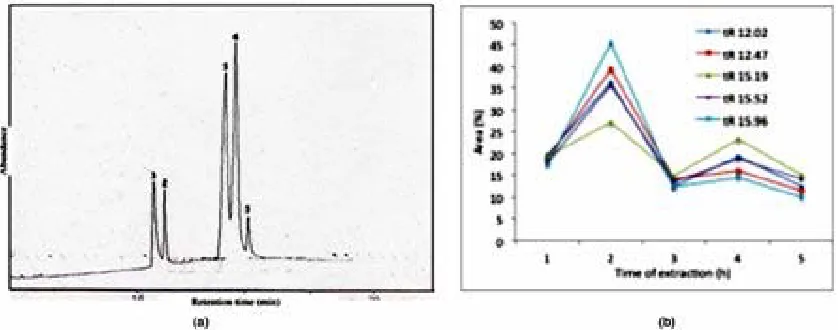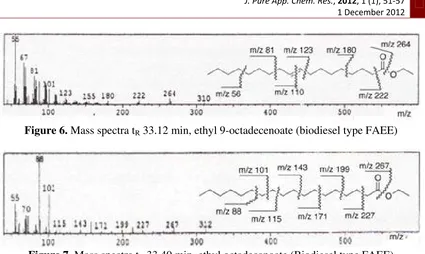The journal homepage www.jpacr.ub.ac.id ISSN : 2302‐4690
51
Renewable Oil Extracted from Indonesian Srikaya’s (
Annona
squamosa
sp.) Seed: Another Potent Source for Biodiesel
Masruri,1* Mukesh Sharma,2 Warsito,1 and Prasetyo Adi3
1
Laboratory of Organic Chemistry, Department of Chemistry, Brawijaya University Jl. Veteran No. 1 Malang, Indonesia 65145
2
Research School of Chemistry, Australian National University, Canberra ACT 0200 Australia 3
Faculty of Medicine, Brawijaya University, Jl. Veteran No. 1 Malang Indonesia 65145 Email contact : masruri@ub.ac.id
Received 19 April 2012; Accepted 1 July 2012
ABSTRACT
This study looks at the wastes derived from Indonesian fruit as prospect for biofuels. This report investigates the chemical composition of Srikaya (Annona squamosal sp.) seed, which is disposed as waste products from traditional markets. The seeds were extracted with various extraction methods and the oil obtained was analysed by means of gas chromatography (GC/FID), gas chromatography-mass spectrometry (GC/MS), infra-red spectrometry and ultra-violet-visible spectrometry. It was found 2 h extraction using soxhlet apparatus with diethyl ether as solvent gave the optimum time extraction. Moreover, five major components were isolated from i.e.: ethyl hexadecanoate, ethyl hexadec-9-enoate, ethyl octadecanoate, 2-hydroxy-1,3-propanediyl hexadecanoate, octadec-9-enaldehyde, and unknown compound, respectively.
.
Key word: Annonaceae, Annona squamosa, Srikaya, FAME, FAEE, biodiesel
INTRODUCTION
Indonesia has a high diversity of indigenous fruits and plants. This become a unique point and able to promote an innovative economic to improve national and local community income. The un-explore of the potency of local fruit remains an issue for increasing their value. With increasing global and national demand for biofuel from plant, it is focused on exploring other new sources of biofuels besides indonesian palm, since the main source of indonesian biofuel is the palm oil. oil [1]. Conversion of palm oil's fatty acid into fatty acid ethyl ester (FAEE) and methyl ester (FAME) yields biofuel that can be used directly in diesel motors [2]. For instance, ethyl oleate (FAEE) and methyl oleate (FAME) can be derived from Indonesian crude palm oil (CPO) by transterification process employing an acid or basic catalyst (Figure 1).
The journal homepage www.jpacr.ub.ac.id ISSN : 2302‐4690
52 Srikaya (Annona squamosa L.; Javanesse known as Srikoyo) [3], is a family plant of annonaceae (Figure 2), and include in this member is sirsat (Annona muricata), apel mete (Annona glabra), and buah nona (Annona reticulata) [5]. East Java Indonesia is the main producer even though it is widely distribution to all the regions. Traditionally is marketed as family fruit for daily consumption or as a source of the other food products in home industry. However, the seeds were disposed as waste.
Figure 2. Srikaya (Annona squamosal sp.) fruit [4]
Research toward this fruit especially seed phytochemistry has become interest for its biological acitivity. Part of this plant was reported had activity as antioxidant [6], insecticide [7], anticancer [8] and antibacterial [9]. Furthermore, the chemical composition from part of plant had been reported as well with different chemical composition according to the procedure isolation and origine of the plant. Volatile constituent mainly contained garmacrene, caryophylene oxide, and kaur-16-ene. These were obtained by steam distillation [9a]. Tetrafuranic acetogenine was also isolated using petroleum eter extraction [10]. Kaur-16-en-18-oic acid was isolated from lipid fraction, and α-pinene, sabinene, limonene including isorecinoleic acid were detected in essential oils of seed [11]. Cyclopeptide squamin-A was also reported composing seed polar extract [12], anti-malarial alkaloide was also reported as N-nitrosoxylopine, roemerolidine and duguevalline [13].
EXPERIMENT
Material and instrumentations
Annona squamosa fruit was bought from traditional local market in Malang, East Java, Indonesia. The sample was identified in the Laboratory of Taxonomy, University of Brawijaya by drs Djati Batoro, and the speciment was deposited in this laboratory. The seeds for this study were collected from ripened fruit, and grinded using home-blender without a prior drying process. The powdered seed was wrapped with Whatman paper for soxhlet extraction.
The journal homepage www.jpacr.ub.ac.id ISSN : 2302‐4690
53 Extraction
A 500 mg of srikaya’s seed powder was extracted using soxhlet with diethyl ether (150 mL) as a solvent. A 0.1 mL crude sample was taken every hour for 5h for GC/FID monitoring. The extraction was continued for 5 h. After 5 hours the ether extract was dried using MgSO4, filtered and evaporated in-vacuo to yield a yellowish-brown oils (1.22 mL, d. 0.96 g/mL, 23.4% yield). Analysis of the oil was performed using FTIR, UV-Vis, and GCMS. The mass spectra resulted was mainly used for further chemical identification by comparing the spectra resulted with known spectra on the library provided from National Institute of Standard and Technology (NIST).
RESULT AND DISCUSSION
The progress of soxhlet extraction of the grounded seed was monitored by GC/FID. Aliquotes of 0.1 mL was collected every hour for 5 hours. Figure 3a is displayed GC chromatogram of sample for 2 hour extration. Minimum of five compounds were present with two major components indicated by peak 3 and 4. Extraction was continued for 5 h, when the extraction process indicated clear appearance. Concentration of the solvent under reduced pressure afforded the yellow-brown oils (23.4% yield, d. 0.96 g/mL, 25 oC). The graph presented in Figure 3b shows the correlation between compositions of each compound/peak over 5 h. It gave optimum extraction at 2 h, at which compound with retention time of 15.96 min was present as a dominant component, however it decrease afterwards and compound with retention time of 15.19 min was found to be dominant at later stages of the extraction. In general, all components were found to be present in highest percentage in sample obtained for the 2 h extraction
Figure 3. Chromatogram of GC/FID after 2 h soxhlet extraction (a), and their composition after 5 h extraction (b)
Determination by GCMS of the oils provided slightly similar chromatogram, and showed the presence of 7 compounds. It was recorded 7 compounds composed the oils (Figure 4). Analysis of the mass spectrum and comparision with the library spectra (NIST databased spectra) resulted in the identification of 6 of the 7 compounds (Table 1). Compound at tR 31.10, 33.13, and 9.36 minute were known as fatty acid ethyl ester (FAEE).
The journal homepage www.jpacr.ub.ac.id ISSN : 2302‐4690
54 Figure 4. The GCMS chromatogram of srikaya's renewable oils
Table 1. Composition of the renewable oil from srikaya’s seed
No tR
(minute) Percentage Name
Molecular formula (MW) 1 25.24 1.21% 2,6-di-tert
-butyl-3,5-bis(3-methylbut-2-en-1-yl)phenol
C24H38O (342)
2 31.10 14.9% Ethyl hexadecanoate C18H36O2 (284)
3 33.12 57.4% Ethyl hexadec-9-enoate C20H38O2 (310)
4 33.40 9.36% Ethyl octadecanoate C20H40O2 (312)
5 34.84 1.32% 2-Hydroxy-1,3-propanediyl hexadecanoate
C35H68O5 (568)
6 37.66 7.67% Octadec-9-enaldehyde C18H34O (266)
7 37.92 8.14% Unknown C24H38O (342)
Fragmentation analysis of the FAEE spectra supported the determination. Ethyl hexadecanoate spectra (Figure 5) recorded ion molecule at m/z 284. Further fragmentation through McLafferty rearrangement on α and β position resulted peak at mz 88 and 101 [14]. In the other spectra fragmentation for ethyl 9-octadecenoate (Figure 6) and ethyl octadecanoate (Figure 7) gave a similar pattern cleavage. Both provided ion molecule peaks at m/z 310 and 312, respectively.
The journal homepage www.jpacr.ub.ac.id ISSN : 2302‐4690
55 Figure 6. Mass spectra tR 33.12 min, ethyl 9-octadecenoate (biodiesel type FAEE)
Figure 7. Mass spectra tR 33.40 min, ethyl octadecanoate (Biodiesel type FAEE)
In addition to the identified FAEE compounds, one aldehyde compound was detected as octa-9-decenaldehyde (tR 37.66 min) in 7.67% (Figure 8). Two compounds was also could
be detected as diisoprenylated of di-tert-butylphenol and 1,3-disubstituted of stearyl bishexadecanoate. Both of this was detected in 1.21% and 1.32%, respectively. Moreover, compound (tR 37.92 min) with molecular formula C24H38O and molecular weight 342
remains unidentified.
Figure 8. Mass spectra tR 37.66 min, octadec-9-enaldehyde
The journal homepage www.jpacr.ub.ac.id ISSN : 2302‐4690
56 The infrared spectrometer spectra gave clear evidence of the functional group of FAEE composed the srikaya oils (Figure 9a). A strong band at 1745 cm-1 indicated carbonyl group strecthing absorption. The presence of ester was also supported with peaks in the fingerprint region for C-O-C bending absorption at 1061 and 1047 cm-1. No significant hydroxyl, amine and amide band was detected. The UV-Vis spectra gave λmax for the oils at 275 nm (Figure 9b).
CONCLUSIONS
To summarise, srikaya seed contained a dominant (81.7%) and potential fatty acid ethyl ester (FAEE), a type of recent developed renewable oil for biodiesel. Three structures FAEE found were ethyl hexadecanotae, ethyl 9-octadecenoate and ethyl octadecanoate.
ACKNOWLEDGMENT
MSR thank to PT. POS Indonesia for scholarship, Laboratory of Organic Chemistry Gadjah Mada University for GCMS analysis. Part of this research was submitted to fulfill part of degree requirement in Chemistry.
REFERENCES
[1] Suratin Subur, Pabrik Biodiesel Terintegrasi: Terobosan untuk Mempercepat Pengembangan Biodiesel, Lembaga Riset Perkembangan Indonesia, http://www.ipard.com/art_perkebun/may24-06_wrs.asp was accessed on15 December 2006
[2] (a) Divya Bajpai and V. K. Tyagi, Journal of Oleo Science, 2006, 55 (10), 487-502; (b) Choo Yuen May, Ma Ah Ngan, Cheah Kien Yoo, Rusnani Abdul Majid, Andrew Yap Kian Chung, Harrison Lau Lik Nang, Cheng Sit Foon, Yung Chee Liang, Puah Chiew Wei, Ng Mei Han and Yusof Basiron, Palm Oil Development, 42, 3-7 (Downloaded from http://download/Palm%20Oil%20Developments/june%202005/Palm%20Diesel-%20 Greenhttp://download/Palm%20Oil%20Developments/june%202005/Palm%20Diesel-%20andhttp://download/Palm%20Oil%20Developments/june%202005/Palm%20Diesel-%20Renewablehttp://download/Palm%20Oil%20Developments/june%202005/Palm%20Diesel-%20Fuelhttp://download/Palm%20Oil%20Developments/june%202005/Palm%20Diesel-%20Fromhttp://download/Palm%20Oil%20Developments/june%202005/Palm%20Diesel-%20Palmhttp://download/Palm%20Oil%20Developments/june%202005/Palm%20Diesel-%20Oil.pdf, date access July 30, 2012).
[3] Heyne, K., Tumbuhan Berguna Indonesia, 1987, Badan Penelitian dan Pengembangan Kehutanan, Departemen Kehutanan, Jakarta ((Indonesian).
[4] Picture was taken from http://t1.gstatic.com/images?q=tbn:ANd9GcQkVMDF8F-H3aOOAFsJAFyPUHFgnARTKEv-PRI24f6OqfWlUsXq (downloaded in May 8th, 2012).
[5] (a) Steenis, G.G.J, 1978, Flora untuk sekolah di Indonesia, PT Pradnya Paramita, Jakarta; (b) Kapil Vyas, Hansraj Manda, Rahul K. Sharma and Gaurav Sinhal, Int. J. Pharm. Th., 2012, 3 (2), 107-118
[6] Panchawat S., Rathore K.S. and Sisodia S.S., Int. J. Pharm. Tech. Res., 2010, 2 (1), 232-239.
[7] (a) Amini, Study on nsectisidal principal of seed of annona species found in Indonesia, Project report of University of Gadjah Mada and USAID, May 31, 1988; (b) S. Anita, P. Sujatha, and P. Prabudhas, Recent Res. Sci. Technol., 2012, 4 (20), 19-23.
[8] (a) B. V. V. Pardhasaradhi, Madhurima Reddy, A. Mubarak Ali, A. Leela Kumari and Ashok Khar, J. Biosci., 2005, 30 (2), 237-244; (b) K. Suresh, S. Manoharan, K. Panjamurthy and K. Kavita, Pak. J. Biol. Sci., 2006, 9 (14), 2600-2605.
The journal homepage www.jpacr.ub.ac.id ISSN : 2302‐4690
57 2011, 7 (1), 133-142; (c) P.S. Asher, Y. S. Shinde and P. P. Chavan, IJPSR, 2012, 3 (5), 1457-1460.
[10] Hiroshi Araya,Bull. Natl. Inst. Agro-Environ. Sci., 2004, 23, 77-149.
[11] Eloisa Helena A. Andrade, Maria das Gracas B. Zoghbi, Jose Guilherme S. Maia, Heinz Fabricus, and Friedhelm Marx, J. Food Compos. Anal., 2001, 14 (2), 227-232. [12] Jian Xia SHI, Hou Ming WU, Fa Hu HE, Kenichiro INOUE, and Zhi Da MIN,
Chinese Chem. Lett., 1999, 10 (4), 299-302
[13] Tylor Johns, Arnold Windust, Thomas Jurgens, and Saleh Muhammad Mansor, Phytopharmacology, 2011, 1 (3), 49-53.

![Figure 2. Srikaya (Annona squamosal sp.) fruit [4]](https://thumb-ap.123doks.com/thumbv2/123dok/1587727.1548957/2.612.241.370.195.294/figure-srikaya-annona-squamosal-sp-fruit.webp)


